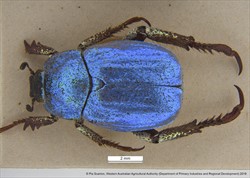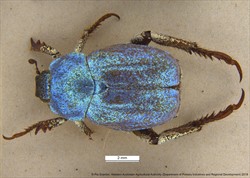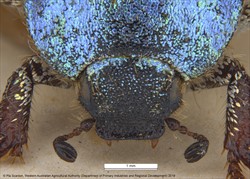Sub family: Melolonthinae / Tribe: Hopliini / Genus: Hoplia
Fact Sheet
Hoplia Illiger, 1803
Generally small beetles, 5.3-13mm in length. Body colouration greatly varies (dark blacks and browns, through to bright blues, greens, yellows and orange), variable even within species and between males and females. With a metallic sheen. Dorsal/ventral scales sometimes present, scarce, patterned, or completely covering body. Clypeus subquadrate, labrum distinct, located below clypeus. Antennae 9-10 segmented. Pronotum sometimes with a plain rounded posterior border, sometimes with basomedial emargination around scutellum. Membraneous border present on its anterior margin. Propygidium separated from the 5th abdominal sternite by a suture. Metatibial spurs absent, Metatarsus with a single, simple claw.
Also known as the Monkey beetle, some adults of Hoplia are known to feed on leaves of a variety of plants during daytime hours. Others are known to feed on the developing early buds and flowers, causing significant damage to a range of ornamentals, grapes, peaches and almonds.
Larvae of some species are recognised pests, feeding on the roots of turf, ornamentals, trees and shrubs.
The host plants of many species remain unknown.
Hoplia is a widespread genus across Palearctic, Nearctic, Neotropical, Oriental and Southern African biogeographic realms. It is absent from Australia.
UC IPM Pest Note for Hoplia callipyge: http://ipm.ucanr.edu/PMG/PESTNOTES/pn7499.html
Hardy, A.R. 1977 A revision of the Hoplia of the Nearctic Realm (Coleoptera: Scarabaeidae) Occasional Papers in Entomology 23: 48 pp.






